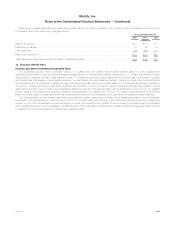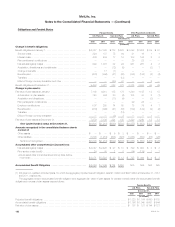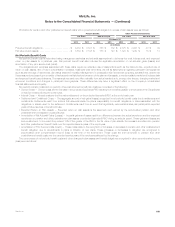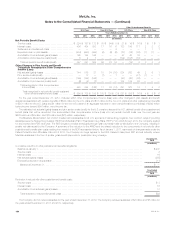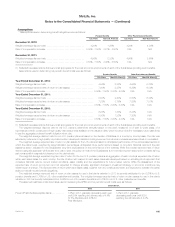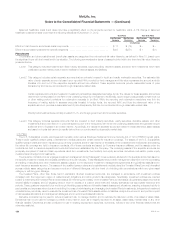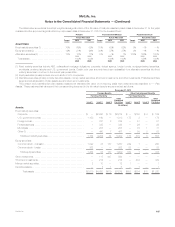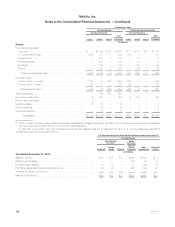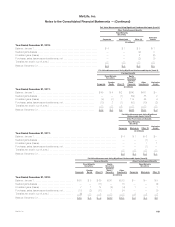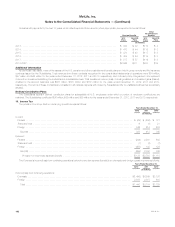MetLife 2012 Annual Report Download - page 192
Download and view the complete annual report
Please find page 192 of the 2012 MetLife annual report below. You can navigate through the pages in the report by either clicking on the pages listed below, or by using the keyword search tool below to find specific information within the annual report.
MetLife, Inc.
Notes to the Consolidated Financial Statements — (Continued)
Assumed healthcare costs trend rates may have a significant effect on the amounts reported for healthcare plans. A 1% change in assumed
healthcare costs trend rates would have the following effects as of December 31, 2012:
U.S. Plans Non-U.S. Plans
One Percent
Increase One Percent
Decrease One Percent
Increase One Percent
Decrease
(In millions)
Effect on total of service and interest costs components ................................ $ 17 $ (14) $— $—
Effect of accumulated postretirement benefit obligations ................................ $308 $(251) $ 1 $ (1)
Plan Assets
The pension and other postretirement benefit plan assets are categorized into a three-level fair value hierarchy, as defined in Note 10, based upon
the significant input with the lowest level in its valuation. The following summarizes the types of assets included within the three-level fair value hierarchy
presented below.
Level 1 This category includes investments in fixed maturity securities, equity securities, derivative assets, and short-term investments which have
unadjusted quoted market prices in active markets for identical assets and liabilities.
Level 2 This category includes certain separate accounts that are primarily invested in liquid and readily marketable securities. The estimated fair
value of such separate account is based upon reported NAV provided by fund managers and this value represents the amount at which
transfers into and out of the respective separate account are effected. These separate accounts provide reasonable levels of price
transparency and can be corroborated through observable market data.
Certain separate accounts are invested in investment partnerships designated as hedge funds. The values for these separate accounts is
determined monthly based on the NAV of the underlying hedge fund investment. Additionally, such hedge funds generally contain lock out
or other waiting period provisions for redemption requests to be filled. While the reporting and redemption restrictions may limit the
frequency of trading activity in separate accounts invested in hedge funds, the reported NAV, and thus the referenced value of the
separate account, provides a reasonable level of price transparency that can be corroborated through observable market data.
Directly held investments are primarily invested in U.S. and foreign government and corporate securities.
Level 3 This category includes separate accounts that are invested in fixed maturity securities, equity securities, derivative assets, and other
investments that provide little or no price transparency due to the infrequency with which the underlying assets trade and generally require
additional time to liquidate in an orderly manner. Accordingly, the values for separate accounts invested in these alternative asset classes
are based on inputs that cannot be readily derived from or corroborated by observable market data.
U.S. Plans
The U.S. Subsidiaries provide employees with benefits under various Employee Retirement Income Security Act of 1974 (“ERISA”) benefit plans.
These include qualified pension plans, postretirement medical plans and certain retiree life insurance coverage. The assets of the U.S. Subsidiaries’
qualified pension plans are held in insurance group annuity contracts, and the vast majority of the assets of the postretirement medical plan and backing
the retiree life coverage are held in insurance contracts. All of these contracts are issued by Company insurance affiliates, and the assets under the
contracts are held in insurance separate accounts that have been established by the Company. The underlying assets of the separate accounts are
principally comprised of cash and cash equivalents, short-term investments, fixed maturity and equity securities, derivatives, real estate, private equity
investments and hedge fund investments.
The insurance contract provider engages investment management firms (“Managers”) to serve as sub-advisors for the separate accounts based on
the specific investment needs and requests identified by the plan fiduciary. These Managers have portfolio management discretion over the purchasing
and selling of securities and other investment assets pursuant to the respective investment management agreements and guidelines established for
each insurance separate account. The assets of the qualified pension plans and postretirement medical plans (the “Invested Plans”) are well diversified
across multiple asset categories and across a number of different Managers, with the intent of minimizing risk concentrations within any given asset
category or with any given Manager.
The Invested Plans, other than those held in participant directed investment accounts, are managed in accordance with investment policies
consistent with the longer-term nature of related benefit obligations and within prudent risk parameters. Specifically, investment policies are oriented
toward (i) maximizing the Invested Plan’s funded status; (ii) minimizing the volatility of the Invested Plan’s funded status; (iii) generating asset returns that
exceed liability increases; and (iv) targeting rates of return in excess of a custom benchmark and industry standards over appropriate reference time
periods. These goals are expected to be met through identifying appropriate and diversified asset classes and allocations, ensuring adequate liquidity to
pay benefits and expenses when due and controlling the costs of administering and managing the Invested Plan’s investments. Independent investment
consultants are periodically used to evaluate the investment risk of Invested Plan’s assets relative to liabilities, analyze the economic and portfolio impact
of various asset allocations and management strategies and to recommend asset allocations.
Derivative contracts may be used to reduce investment risk, to manage duration and to replicate the risk/return profile of an asset or asset class.
Derivatives may not be used to leverage a portfolio in any manner, such as to magnify exposure to an asset, asset class, interest rates or any other
financial variable. Derivatives are also prohibited for use in creating exposures to securities, currencies, indices or any other financial variable that are
otherwise restricted.
186 MetLife, Inc.







